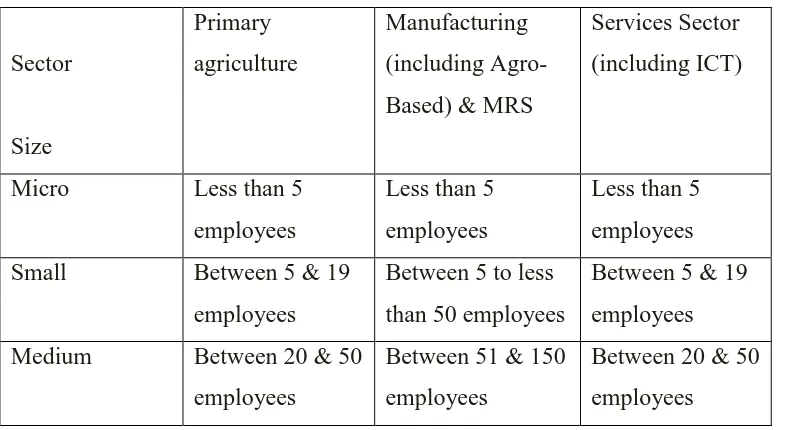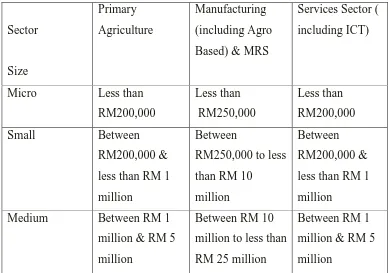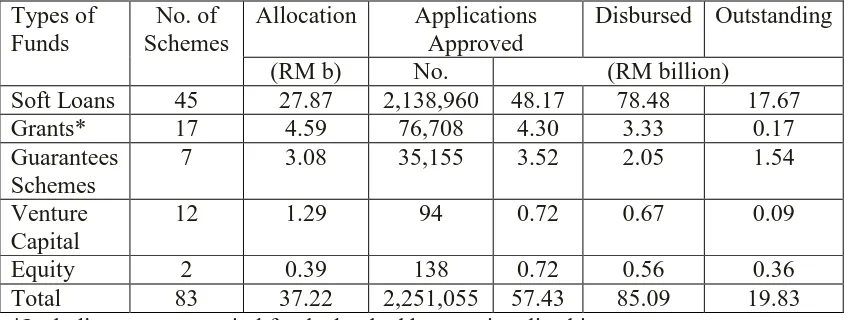“We acknowledge that we have read this thesis and in our opinion this thesis is sufficient in terms of scope and quality for the award of Bachelor of Technology Management
(Innovation Technology)”
Signature : ………
Name of Main Supervisor : Puan Murzidah binti Ahmad Murad
Date : 24 June 2013
Signature : ………
Name of Joint Supervisor : Dr. Norain binti Ismail
i
THE FINANCING OF SMALL AND MEDIUM SIZED ENTERPRISES (SMEs) AND THE IMPACT TO BUSINESS PERFORMANCE IN MELAKA FOOD
INDUSTRY
SITI RASYIDAH BINTI BASIRON
This report submitted in
partial fulfillment of the requirements for
the award of Bachelor of Technology Management (Innovation)
Faculty of Technology Management and Technopreneurship Universiti Teknikal Malaysia Melaka
ii
“I truly admit that this report is my own writing except the summary and citations that I have mentioned their sources.”
Signature : ………
iii
This thesis is dedicated to my parents; Mak and Abah
iv
ACKNOWLEDGEMENT
In the name of Allah, the Most Gracious and the Most Merciful
Alhamdulillah, all praises to Allah for the strengths and His blessing in completing this research. I would like to extend my deepest gratitude to all those who have directly and indirectly guide and help me to complete this research.
Special appreciation to my supervisor, Puan Murzidah binti Ahmad Murad for the patient guidance, encouragement and advice she has provided throughout my time as her student. I have extremely lucky to have a supervisor who considers and cared about my research. I appreciate all valuable information that make easier to write the report.
I would like to convey my gratitude to my Research Method lecturer, Dr. Chew Boon Cheong for his priceless guidance directly and indirectly: whether in class or his blog about a research method subject toward making a good research. I feel so grateful to be his student as he always support and encourage all students with invaluable words.
Sincere thanks to all my housemate especially Naziatul, Zarin, Izzati and Syahirah for their kindness and moral support throughout my study. Thanks for friendship and memories.
v ABSTRACT
vi ABSTRAK
vii
LIST OF CONTENT
CHAPTER TOPIC PAGES
CONFESSION ii
DEDICATION iii
ACKNOWLEDGEMENT iv
ABSTRACT v
ABSTRAK vi
LIST OF CONTENT vii
LIST OF TABLE x
LIST OF FIGURE xi
LIST OF ABBREVIATION xii
LIST OF APPENDIX xiii
CHAPTER 1 INTRODUCTION 1
1.1 Introduction/Background of Study 1 1.2 Statement of Problem / Research Question 2
1.3 Research Objective 2
1.4 Scope 3
1.5 Limitation 3
1.6 Importance of The Project 4
viii
CHAPTER 2 LITERATURE REVIEW 5
2.1 Introduction 5
2.2 Small and Medium-sized Enterprises (SMEs) 6
2.3 SMEs Financing 8
2.4 Capital Structure theory 10
2.5 Business performance 11
2.6 Theoretical Framework 12
2.7 Hypothesis 13
2.8 Summary 14
CHAPTER 3 RESEARCH METHOD 15
3.1 Introduction 15
3.2 Research Design 15
3.3 Quantitative Research 16
3.4 Primary and Secondary Data Sources 16
3.5 Location of The Research 17
3.6 Method of Primary Data Collection 17
3.7 Questionnaire Design 18
3.7 Data analysis 18
3.8 Summary 20
CHAPTER 4 RESULT AND DISCUSSION 21
4.1 Introduction 21
4.2 Reliability test 22
4.3 Organizational Profile 23
4.4 Respondents Financing Preferences 25 4.5 Impact to Business Performance 27 4.6 Relationship between independent variable
and dependent variables and hypothesis testing
30
ix
CHAPTER 5 CONCLUSION AND SUGGESTIONS 33
5.1 Introduction 33
5.2 Summary of main finding 34
5.3 Suggestion to overcome / improve something 35 5.4 Recommendation for further studies 36
References 37
x
LIST OF TABLE
NO TOPIC PAGES
2.1 SMEs definition based on number of full-time
employees 5
2.2 SMEs definition based on annuals sales turnover 6 2.3 Performance of Government Funds and Schemes as at
December 2010 9
4.2.1 Reliability Statistics 22
4.5.1 Mean and standard deviation for Turnover and financial management
27
4.5.2 Mean and standard deviation for Return on Investment 28 4.5.3 Mean and standard deviation for revenue, profit and
margin
28
xi
LIST OF FIGURE
NO TOPIC PAGES
2.2 Theoretical Framework 11
4.3.1 Firm’s Age 23
4.3.2 Firm’s Size 24
xii
LIST OF ABBREVIATION
SMEs Small and Medium Enterprises GDP Gross Domestic Product SMIs Small and Medium Industries
SMIDEC Small and Medium Industries Development Corporation SPSS Statistical Package of Social Sciences
xiii
LIST OF APPENDIX
NO TOPIC PAGES
1. Appendix A : Permission Letter 40
2. Appendix B : Questionnaire 41
3. Appendix C : Gantt Chart I 46
1 CHAPTER 1
INTRODUCTION
1.1Introduction/ background of the study
2
1.2 Statement of the problem/ Research Question
Based on the contribution of SMEs to GDP in the economy, the government realized the importance of SMEs and provide RM1 billion in 2013 Budget for entrepreneur in accessing the funding. Compared to previous research about SMEs, this topic is concerned about challenges for SMEs in financing. Since the government is encouraging entrepreneur with the allocation to get funding to expand the business, the researcher is interested to investigate about financing preferences adopted by SMEs and how far the financing can impact business performance. The research questions of this case study are as stated below:
1. What are the types of SMEs financing preferences in Melaka food industry? 2. What is the impact of financing sources to business performance?
3. Does SMEs financing have a positive relationship to business performance?
1.3 Objectives
There are three objectives of this research study as stated below:
1. To identify types of SMEs financing preferences in Melaka food industry. 2. To investigate the impact of financing sources to business performance. 3. To examine the relationship between financing and business performance.
1.4 Scope
3 1.5 Limitation
1.5.1 Time constraint
The major limitation in conducting this research is due to time constraint. Since this study only takes about one year, there is a time limitation to complete this research. As a degree student, the researcher has another commitment to do. In order to get accurate data, it is a must for the researcher to allocate a long period of time in order to obtain all necessary information. However this research has limited time to gather relevant information on selected topics upon conducting this study hence makes time constraint obviously is the utmost limitation for this case study.
1.5.2 Lack of respondent’s co-operation
Some of the respondents refused to give full co-operation during the questionnaire survey distribution since the times used to distribute the questionnaire were during office hours.
1.5.3 Cost to conduct the research
In order to prepare and finish this research, the cost involved is quite high especially for printing, photocopy of questionnaire for the entire respondent and transportation cost used for questionnaire distribution.
1.6 Importance of the Project
4
(SMIs) is about 1 million under SME bank. The value of this project can be appraised based on the result of the finding.
1.7 Summary
5 CHAPTER 2
LITERATURE REVIEW
2.1 Introduction
6
2.2 Small and Medium-sized Enterprises (SMEs)
There are different parameters about definitions in SMEs based on the researchers in earlier studies. However, according to Bhaird,M.A. (2010), “definitions are not static and will change constantly to reflect to economies condition, productivity, and technology change”.
[image:20.595.126.527.439.654.2]SME is defined as a company with no more than 500 employees (Oxford Dictionary, 2012). A general definition specified by the Small and Medium Industries Development Corporation (SMIDEC) can be grouped into three categories which are Micro, Small or Medium. There are two main factors to consider whether the numbers of people a business employs or according to total sales or revenue generated by a business in a year. Table 2.1 and Table 2.2 show the SMEs definition based on two factors stated.
Table 2.1: SMEs definition based on number of full-time employees (Sources: Small Medium Industries Development Corporation)
Sector Size Primary agriculture Manufacturing (including Agro-Based) & MRS
Services Sector (including ICT)
Micro Less than 5 employees
Less than 5 employees
Less than 5 employees Small Between 5 & 19
employees
Between 5 to less than 50 employees
Between 5 & 19 employees Medium Between 20 & 50
employees
Between 51 & 150 employees
7
Table 2.2: SMEs definition based on annuals sales turnover (Sources: Small Medium Industries Development Corporation)
Sector Size Primary Agriculture Manufacturing (including Agro Based) & MRS
Services Sector ( including ICT)
Micro Less than RM200,000
Less than RM250,000
Less than RM200,000
Small Between
RM200,000 & less than RM 1 million
Between
RM250,000 to less than RM 10 million
Between RM200,000 & less than RM 1 million
Medium Between RM 1 million & RM 5 million
Between RM 10 million to less than RM 25 million
Between RM 1 million & RM 5 million
8 2.3 SMEs Financing: Types of Resources
The sources of capital available in Malaysian SMEs can be found in three types which are personal saving (bootstrap) , equity financing, bank loans, financing with debt, and the government (SMIDEC,. 2012)
2.3.1Bootstrap Financing
Personal saving or bootstrap financing is categorized as internal sources. Basically this source is used to start-up the business. It is important to note some basic different between small to medium sized enterprises (SMEs) and large firm in relation to financing. Compared to large firms, they are mostly rely on more heavily bootstrap financing in the form of retained profit (Tim,M., 2011).
2.3.2Equity financing
Equity financing is the money that investor puts into a private company in return for a share in the ownership of that business (Black, A.,2007). According to SME Corporation, Bank loans can be defined as bank lends money to existing business but for a start-up, it may be very difficult to get a bank loan as they do not have a track record. This includes a track record of good cash flow to allow for repayments plus adequate shareholder funds or working capital that can cover any short term cash requirement and ensure the solvency (Tim,M.,2011).
Venture Capital
9 2.3.3 Non-Equity financing
Debt Financing
Financing a business with debt involves securing a loan. This can be happened in the form of unsecured or secured debt. Unsecured debt refers to a taken without having to put up any specific form of security or collateral (SMIDEC, 2012).
Loans
Loans are repaid monthly from cash flow and are secured by an asset or personal. The sources of loan can be getting from personal loan, mortgage loan, and insurance loan.
Government/ Grants
Government is one of the important sources to access finance. According to SMIDEC there are a variety of loans provided by the government in order help an entrepreneur especially to Bumiputeras. These types of loans are under the Financial Institution like Development Financial Institutions (DFIs) and commercial bank. While grant means a special fund, neither equity debt or equity designed to aid business in a specific area( Bruton and Bamford, 2006).
10
Table 2.3: Performance of Government Funds and Schemes as at December 2010 (Source: SME Corporation Malaysia; Annual Report 2010/2011) Types of
Funds
No. of Schemes
Allocation Applications Approved
Disbursed Outstanding
(RM b) No. (RM billion)
Soft Loans 45 27.87 2,138,960 48.17 78.48 17.67
Grants* 17 4.59 76,708 4.30 3.33 0.17
Guarantees Schemes
7 3.08 35,155 3.52 2.05 1.54
Venture Capital
12 1.29 94 0.72 0.67 0.09
Equity 2 0.39 138 0.72 0.56 0.36
Total 83 37.22 2,251,055 57.43 85.09 19.83 *Including venture capital funds that had been rationalised into grants
Based on table 3, Malaysia SMEs involved types of funds approved to 2.2 Million SMEs which are from soft loans, grants, guarantee schemes, venture capital and equity. Based on the annual report employed by SME Corporation Malaysia, the total amount is about RM 57.4 billion. The researcher will investigate how far the finance by government and non-government can impact to business performance. According to Bhaird, C.M.A.,(2010) stated that the youngest age firm are employed from external sources in term of short and long term debt to run the business.


